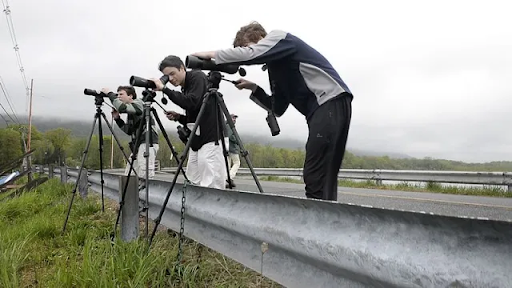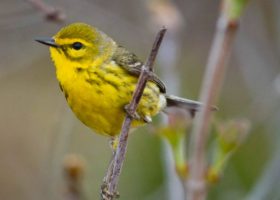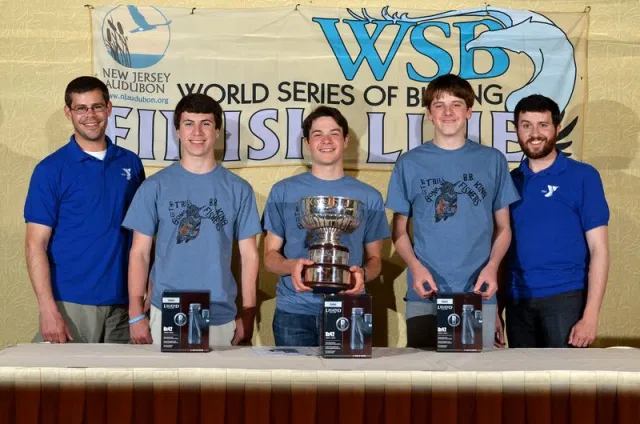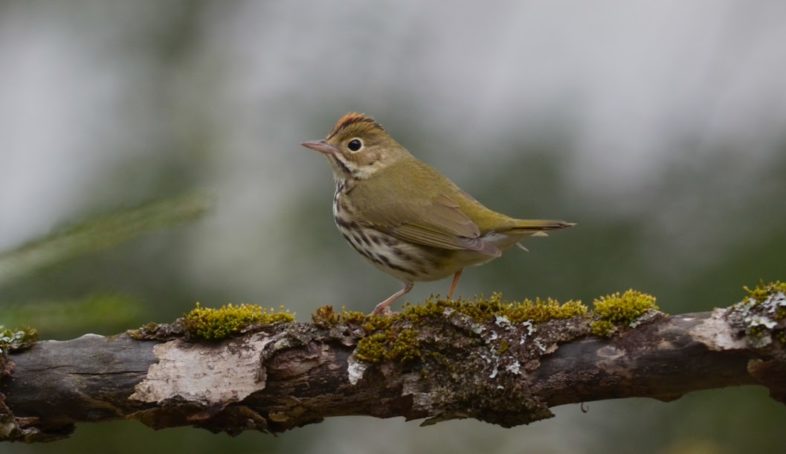
Nathaniel Sharp, Ben Bussmann, and Austin Smith scanning for waterfowl during the 2013 World Series of Birding (Photo by Brian Quindlen)
Around 11:30 pm on May 10th, 2013, three bleary-eyed teenagers stepped out of a rented minivan and onto the trail of “The Great Swamp,” a massive wetland birding destination in northern New Jersey. As we fiddled with our headlamps and pulled on rain pants in anticipation of suboptimal weather, the van’s driver, our friend and longtime birding mentor Brian “BQ” Quindlen, locked the car, checked his watch, and uttered: “We’ve got to hurry.”
Speed-walking towards the spot we wanted to reach by the stroke of midnight, we strained to hear the calls of owls, bitterns, and rails over the swishing of our waterproof attire. About a mile down the road, we paused to gather around the tiny blue glowing screen of BQ’s watch–it read 11:59pm. We started a hushed countdown to midnight, punctuated by the honks of a Canada Goose, our first bird species of the 2013 World Series of Birding!
As it happened, we were drenched by a surprise thunderstorm soon after and, being the tallest things for a few hundred yards around, high-tailed it back to the van once the lightning began. It would be another four windy, rain-soaked hours before we heard our second bird of the day. Not to worry though, this was a 24-hour event after all, and we’d have a few more nighttime hours to try for owls and nocturnal marsh birds.

Prairie Warbler © Nathaniel Sharp
After a rough start, our scrappy team managed to bounce back, tallying nearly 30 warbler species and finishing the day with birds like Eastern Screech-Owl, Chuck-Will’s-Widow, and Least Bittern, making up for the nocturnal birds we missed out on the night before. Arriving at the “Finish Line,” we turned in our checklist with a grand total of 186 species to the organizers of the World Series of Birding, a 24-hour birding fundraiser event sponsored by New Jersey Audubon.
After a VERY long day of birding, we collapsed onto our motel beds with the songs of Red-eyed Vireos and American Redstarts still bouncing around in our heads. Gathering together with all of the participants the next morning, it was revealed that we had made history as the first youth birding team to win the entire event, finding more bird species in a 24-hour period than any of the other 60+ teams competing!
On top of the birds and the (surprisingly large) trophy, we were thrilled to have raised hundreds of dollars through sponsorship of our team in support of our local YMCA’s environmental education program.

The Upper Main Line YMCA B.B. Kingfishers with the coveted Urner-Stone Cup. Photo by Kriston J. Bethel (From left to right: Brian Raicich, Nathaniel Sharp, Ben Bussmann, Austin Smith, and Brian Quindlen.
A Big Day is, essentially, a birding holiday. It’s not something you could do every day of the year, or would even want to. The great joy of birding is that during any time of year, a few minutes of quiet observation can bring you in contact with a plethora of bird activity, from Blue Jays caching acorns in fall to a bustling nest of Eastern Phoebes in spring. One day out of the year though, when the sun rises early and bird diversity is skyrocketing, the phenomenal birding conditions paired with a healthy dose of birding camaraderie and friendly competition provide the perfect atmosphere for Big Day birding. The icing on the cake is that oftentimes Big Days are fundraising events, with sponsors and donors pledging their financial support per bird found during the day. A spring day of birding becomes even more exciting when every new bird species found means a couple more dollars raised for bird conservation!

Ovenbird at Union Village Dam, Thetford, VT. © Nathaniel Sharp
I like to think of a Big Day as a really good day of birding with a little structure behind it. You can create a time limit (6am to 6pm, or midnight to midnight if you really want to go all out) and you can set a geographic boundary, maybe your backyard, or your neighborhood, or your county, state, etc.
These kinds of time limits or geographic boundaries to a Big Day encourage planning ahead. Where is the best spot to be at sunrise to hear and see the highest diversity of birds? How will I make sure I don’t miss seeing a Green Heron today? What route should I take to visit all my favorite local birding spots on my bike? Adding birding friends into the mix takes all of this energy, planning, and excitement to the next level. Having the extra eyes and ears helps, obviously, but so does having those extra hands to high-five when an unexpected bird shows up!
If you are considering setting out on a Big Day (or a more stationary Big Sit) of your own, it’s important to know that no matter what kind of Big Day you’re doing, the act of putting in the effort to thoroughly look for birds with the goal of finding as many as possible means that at the end of the day, you’ll be contributing valuable community science data outlining a snapshot of the birds in your area at that point in time. To further bump up the value of your Big Day bird data, consider focusing your effort on an area where not many people go birding, or maybe try to document as many birds exhibiting breeding behaviors in a day as you can.
By keeping track of the birds you see and hear and submitting that list to a community science database like eBird, you’re helping build a better understanding of bird populations and diversity! Last year, 305 folks across Vermont went birding on the same gorgeous May day, filling out 724 Vermont eBird checklists with a combined 178 bird species, replete with 298 photos and audio recordings while contributing to VCE’s 2020 Backyard Bird Quest. That kind of intense birding effort on a single day over multiple years provides invaluable information to help better understand the populations and distributions of the birds that migrate through or breed in Vermont.
Every year since my first World Series of Birding experience more than a decade ago, I eagerly anticipate the arrival of spring migration both for the excitement of newly arriving birds and for the thrill of getting some birding friends together and spending the day doing what we love most. This year I’ll be setting a pre-sunrise alarm hoping to hear the local Barred Owl and check off my first bird of VCE’s Backyard Bird Quest on May 22nd! I hope you’ll join me by birding your backyard or local natural area and contributing a pledge to the VCE staff birding team–the Green Mountain Goatsuckers. With your help, we just might reach our ambitious goal of collectively seeing 200 species in one day across the state of Vermont.
